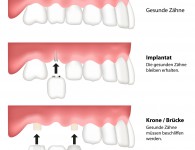Depotphorese, and electro-endophoresis are gentle, painless holistic methods of treatment for root treated teeth.
The root canal is doused in a copper/calcium solution, then a weak electrical current is sent via a fine probe. A reaction takes place and the copper/calcium composite (Cupral) infitrates the root canals. A painless eradication of bacteria is achieved, even in the finest of root canaliculi.
The visible part of the tooth is a stable shell which shelters the nerves, lymph and blood vessels within. If a cavity develops in the hard dental substance (e.g. due to caries), then germs, viruses and fungus can infiltrate the nerve. The nerve has fine ramifications in the surrounding tissue including the jaw bone where the tooth is firmly anchored. Not unlike the crown of a tree, the fine canaliculi bifurcate the tooth and the surrounding area in order to provide nutrients and remove toxins. Once bacteria have taken hold toothache ensues. Sometimes a root nerve simply dies off for no apparent reason. In both cases microbial metabolic products are present in an area which the body identifies as foreign, triggering a defence response. A chain reaction sets in; often a raised blood sedimentation correlates with root treated teeth.
The fundamental idea of a root treatment is to conserve the shell of the dead tooth in order to prevent a gap from developing. This idea is understandible from an historical point of view, as the technical prerequisites (such as bridges or implants) for closing a gap were not yet available. However, compromises had to be made.
Difficulties arise when treating any root canal, of which there can be up to 6, during the complete removal of the natural material surrounding the root including the eradictaion of bacteria, viruses and fungus. In addition to this the hollow root canals had to be filled tightly with a body-compatible root-filling material, in order to prevent the penetration of further bacteria. Due to the anatomical structures of the fine canaliculi correct filling methods are extremely limited from a technical point of view.
Success rates of between 40 and 90 percent can be found in medical journals. Even a large–scale German study manages only 63 percent. Who wants to undergo surgical intervention when the failure rate amounts to 37 percent? It also begs the question: According to which criteria is the success in endotontics (treatment of root canals) measured? Is a 2-dimensional x-ray sufficient to ascertain the patient´s freedom from symptoms, or are finer diagnostic methods such as CT, laboratory parameters or bio-energetic measurements taken into account? The more sensitive the methods of detection are, the worse the chances of success for a root treated tooth are.
Only when tooth anatomy, the principle inflammation and reaction situation of the whole organism and the immunological compatability of the filling material are all taken into account, can an exact assertion be made about the compatibilty and success of the root treatment. From a holistic viewpoint there are few certain indictions for the body tolerance of a root treatment- with the exception of tooth trauma, when a dental nerve dies off as a consequence of an accident (a fall or blow), without any bacterial interference.
Root treatment is only carried out in this practice after weighing up all the pros and cons and in the form of depotphorese in combination with ozone therapy and with previously tested filling material. It is our declared objective to keep any form of stress to the body at an absolute minimum and to avoid any additional irritation to the immunological system.
Fundamentally the medical indication for performing a root treatment should be stringent. In many cases only it would be better for the individual patient to forgo a root treatment and to pursue other possible methods of treatment. In the case of existing chronic underlying disease it is generally advisable to avoid root treatment or to have all previously root treated teeth tested for possible fields of interference and, if need be, to have them extracted.
Bibliography Endophorese
Knappwost, A. Integrale Wurzelbehandlung durch Depotphorese mit Kupfer-Calciumhydroxid Zahnärztliches Forum, LZÄKB (Cottbus) 6, 34 (1992)
Knappwost, A. Anderes Prinzio schafft physiologische Ausheilung in der Endodontie DZW-Spezial 12, S. 28 ff. (2000)
Jeschke, F. Systemvergleich: “Konventionelle” Endodontie versus Depotphorese mit Kupfer-Calciumhydroxid ZMK 11, 715 (1999)
Bokaya, V.G., Lubjanova, S. Depotphorese mit Kupfer-Calciumhydroxid ZMK 11S. 750 ff. (2000)
Fuss, Z., Mizrahi, A., Lin, S., Cherniak, O., Weiss, E. I. A laboratory study of the effect of calcium hydroxide mixed with iodine or electrophoretically activated copper on bacterial viability in dentinal tubules International Endodontic Journal, 35, 522-526, (2002)















